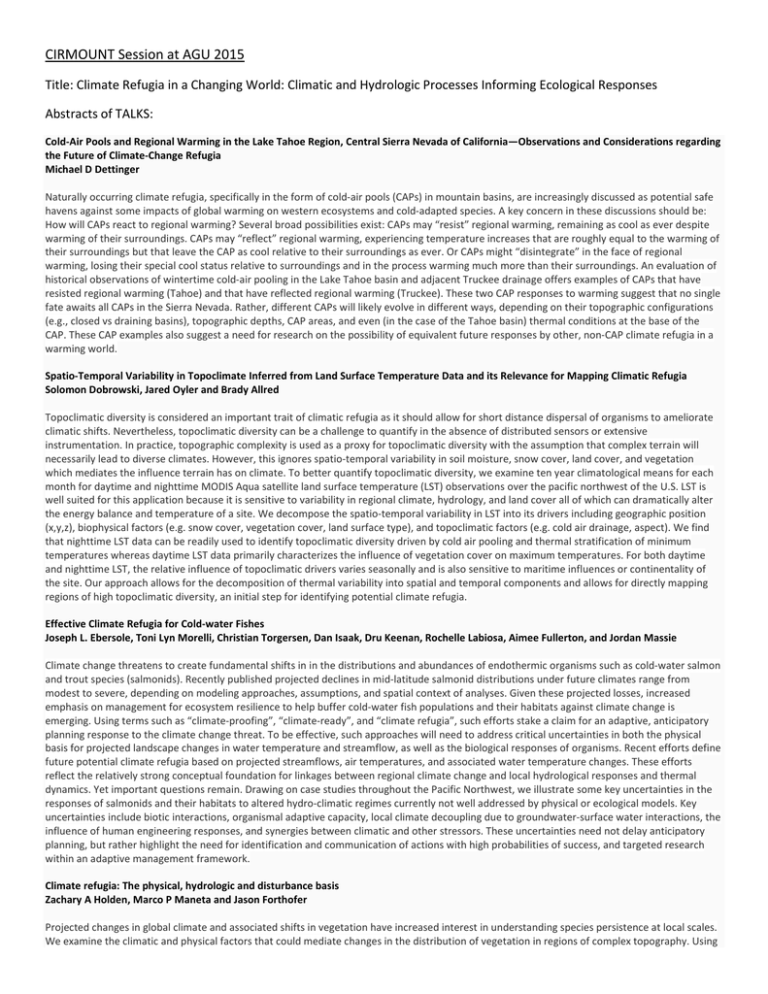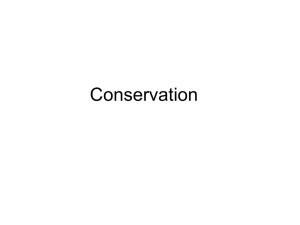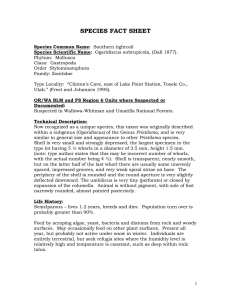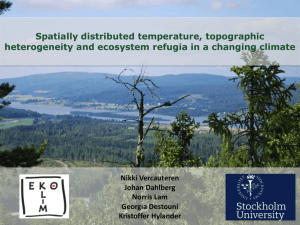CIRMOUNT Session at AGU 2015
advertisement

CIRMOUNT Session at AGU 2015 Title: Climate Refugia in a Changing World: Climatic and Hydrologic Processes Informing Ecological Responses Abstracts of TALKS: Cold-Air Pools and Regional Warming in the Lake Tahoe Region, Central Sierra Nevada of California—Observations and Considerations regarding the Future of Climate-Change Refugia Michael D Dettinger Naturally occurring climate refugia, specifically in the form of cold-air pools (CAPs) in mountain basins, are increasingly discussed as potential safe havens against some impacts of global warming on western ecosystems and cold-adapted species. A key concern in these discussions should be: How will CAPs react to regional warming? Several broad possibilities exist: CAPs may “resist” regional warming, remaining as cool as ever despite warming of their surroundings. CAPs may “reflect” regional warming, experiencing temperature increases that are roughly equal to the warming of their surroundings but that leave the CAP as cool relative to their surroundings as ever. Or CAPs might “disintegrate” in the face of regional warming, losing their special cool status relative to surroundings and in the process warming much more than their surroundings. An evaluation of historical observations of wintertime cold-air pooling in the Lake Tahoe basin and adjacent Truckee drainage offers examples of CAPs that have resisted regional warming (Tahoe) and that have reflected regional warming (Truckee). These two CAP responses to warming suggest that no single fate awaits all CAPs in the Sierra Nevada. Rather, different CAPs will likely evolve in different ways, depending on their topographic configurations (e.g., closed vs draining basins), topographic depths, CAP areas, and even (in the case of the Tahoe basin) thermal conditions at the base of the CAP. These CAP examples also suggest a need for research on the possibility of equivalent future responses by other, non-CAP climate refugia in a warming world. Spatio-Temporal Variability in Topoclimate Inferred from Land Surface Temperature Data and its Relevance for Mapping Climatic Refugia Solomon Dobrowski, Jared Oyler and Brady Allred Topoclimatic diversity is considered an important trait of climatic refugia as it should allow for short distance dispersal of organisms to ameliorate climatic shifts. Nevertheless, topoclimatic diversity can be a challenge to quantify in the absence of distributed sensors or extensive instrumentation. In practice, topographic complexity is used as a proxy for topoclimatic diversity with the assumption that complex terrain will necessarily lead to diverse climates. However, this ignores spatio-temporal variability in soil moisture, snow cover, land cover, and vegetation which mediates the influence terrain has on climate. To better quantify topoclimatic diversity, we examine ten year climatological means for each month for daytime and nighttime MODIS Aqua satellite land surface temperature (LST) observations over the pacific northwest of the U.S. LST is well suited for this application because it is sensitive to variability in regional climate, hydrology, and land cover all of which can dramatically alter the energy balance and temperature of a site. We decompose the spatio-temporal variability in LST into its drivers including geographic position (x,y,z), biophysical factors (e.g. snow cover, vegetation cover, land surface type), and topoclimatic factors (e.g. cold air drainage, aspect). We find that nighttime LST data can be readily used to identify topoclimatic diversity driven by cold air pooling and thermal stratification of minimum temperatures whereas daytime LST data primarily characterizes the influence of vegetation cover on maximum temperatures. For both daytime and nighttime LST, the relative influence of topoclimatic drivers varies seasonally and is also sensitive to maritime influences or continentality of the site. Our approach allows for the decomposition of thermal variability into spatial and temporal components and allows for directly mapping regions of high topoclimatic diversity, an initial step for identifying potential climate refugia. Effective Climate Refugia for Cold-water Fishes Joseph L. Ebersole, Toni Lyn Morelli, Christian Torgersen, Dan Isaak, Dru Keenan, Rochelle Labiosa, Aimee Fullerton, and Jordan Massie Climate change threatens to create fundamental shifts in in the distributions and abundances of endothermic organisms such as cold-water salmon and trout species (salmonids). Recently published projected declines in mid-latitude salmonid distributions under future climates range from modest to severe, depending on modeling approaches, assumptions, and spatial context of analyses. Given these projected losses, increased emphasis on management for ecosystem resilience to help buffer cold-water fish populations and their habitats against climate change is emerging. Using terms such as “climate-proofing”, “climate-ready”, and “climate refugia”, such efforts stake a claim for an adaptive, anticipatory planning response to the climate change threat. To be effective, such approaches will need to address critical uncertainties in both the physical basis for projected landscape changes in water temperature and streamflow, as well as the biological responses of organisms. Recent efforts define future potential climate refugia based on projected streamflows, air temperatures, and associated water temperature changes. These efforts reflect the relatively strong conceptual foundation for linkages between regional climate change and local hydrological responses and thermal dynamics. Yet important questions remain. Drawing on case studies throughout the Pacific Northwest, we illustrate some key uncertainties in the responses of salmonids and their habitats to altered hydro-climatic regimes currently not well addressed by physical or ecological models. Key uncertainties include biotic interactions, organismal adaptive capacity, local climate decoupling due to groundwater-surface water interactions, the influence of human engineering responses, and synergies between climatic and other stressors. These uncertainties need not delay anticipatory planning, but rather highlight the need for identification and communication of actions with high probabilities of success, and targeted research within an adaptive management framework. Climate refugia: The physical, hydrologic and disturbance basis Zachary A Holden, Marco P Maneta and Jason Forthofer Projected changes in global climate and associated shifts in vegetation have increased interest in understanding species persistence at local scales. We examine the climatic and physical factors that could mediate changes in the distribution of vegetation in regions of complex topography. Using massive networks of low-cost temperature and humidity sensors, we developed topographically-resolved daily historical gridded temperature data for the US Northern Rockies. We used the WindNinja model to create daily historical wind speed maps across the same domain. Using a spatially distributed ecohydrology model (ECH2O) we examine separately the sensitivity of modeled evapotranspiration and soil moisture to wind, radiation, soil properties, minimum temperature and humidity. A suite of physical factors including lower wind speeds, cold air drainage, solar shading and increased soil depth reduce evapotranspiration and increase late season moisture availability in valley bottoms. Evapotranspiration shows strong sensitivity to spatial variability in surface wind speed, suggesting that sheltering effects from winds may be an important factor contributing to mountain refugia. Fundamental to our understanding of patterns of vegetation change is the role of stand-replacing wildfires, which modify the physical environment and subsequent patterns of species persistence and recruitment. Using satellite-derived maps of burn severity for recent fires in the US Northern Rockies we examined relationships between wind speed, cold air drainage potential and soil depth and the occurrence of unburned and low severity fire. Severe fire is less likely to occur in areas with high cold air drainage potential and low wind speeds, suggesting that sheltered valley bottoms have mediated the severity of recent wildfires. Our finding highlight the complex physical mechanisms by which mountain weather and climate mediate fire-induced vegetation changes in the US Northern Rocky Mountains. Slow Climate Velocities in Mountain Streams Impart Thermal Resistance to Cold-Water Refugia Across the West Dan Isaak, Mike Young, Charles Luce, Steve Hostetler, Seth J. Wenger, Erin Peterson and Jay Ver Hoef Mountain streams provide important headwater refugia for native fish, amphibians, and other cold-water fauna globally. Although the well documented existence of such refugia indicates some level of resistance to ongoing environmental change, stream warming associated with climate change raises questions about their future persistence. Moreover, evidence exists that air temperatures are warming faster at higher elevations, and some stream temperature models predict that cold streams associated with snowmelt hydrologies will be most sensitive to air temperature increases (i.e. high ratio of stream Δ˚C:air Δ˚C). Here, we estimate stream sensitivities to climate forcing using long-term monitoring records from 927 sites across the topographically complex northwestern U.S. Sensitivity values are combined with high-resolution NorWeST stream temperature scenarios (website:http://www.fs.fed.us/rm/boise/AWAE/projects/NorWeST.html) to map climate velocities at 1 kilometer resolution throughout the 450,000 stream kilometers in the regional network. Our results suggest that cold mountain streams are often ‘double buffered’ against the thermal effects of climate change due to low sensitivities (0.3ºC/ºC) and steep gradients, which translated to very slow climate velocities (<0.35 km/decade for streams >3% slope) from 1968-2011 when air temperatures warmed at the rate of 0.2ºC/decade. Alternative scenarios based on aggressive air temperature warming rates (2x historical rates) and higher sensitivity values of cold streams suggests velocities will remain low in mountain streams due to the dominant effects of steep channel slope and strong local temperature gradients. These results reinforce earlier predictions from high-resolution species distribution models that show which watersheds are most likely to host resilient native trout populations across the West later this century (Climate Shield project website: http://www.fs.fed.us/rm/boise/AWAE/projects/ClimateShield.html). Although other aspects of climate change related to changing hydrology and disturbance regimes may affect stream refuges in mountainous areas, their high thermal resistance should enable many to continue serving as conservatoires of cold-water biodiversity for the foreseeable future. Using biological data to test climate change refugia Toni Lyn Morelli and Sean P Maher The concept of refugia has been discussed from theoretical and paleontological perspectives to address how populations persisted during periods of unfavorable climate. Recently, several studies have applied the idea to contemporary landscapes to identify locations that are buffered from climate change effects so as to favor greater persistence of valued resources relative to other areas. Refugia are now being discussed among natural resource agencies as a potential adaptation option in the face of anthropogenic climate change. Using downscaled climate data, we identified hypothetical refugial meadows in the Sierra Nevada and then tested them using survey and genetic data from Belding’s ground squirrel (Urocitellus beldingi) populations. We predicted that refugial meadows would show higher genetic diversity, higher rates of occupancy and lower rates of extirpation over time. At each step of the research, we worked with managers to ensure the largest impact. Although no panacea, identifying climate change refugia could be an important strategy for prioritizing habitats for management intervention in order to conserve populations. This research was supported by the California LCC, the Northeast Climate Science Center, and NSF. Assessing vulnerable and expanding vegetation stands and species in the San Francisco Bay Area for conservation management under climate change Naia Morueta-Holme, Nicole E Heller, Blair McLaughlin, Stuart B Weiss and David Ackerly The distribution of suitable climatic areas for species and vegetation types is expected to shift due to ongoing climate change. While the pace at which current distributions will shift is hard to quantify, predictions of where climatically suitable areas will be in the future can allow us to map 1) areas currently occupied by a species or vegetation type unlikely to persist through the end of this century (vulnerable stands), 2) areas likely to do better in the future and serve as nuclei for population expansion (expanding stands), and 3) areas likely to act as climate refugia (persisting stands). We quantified the vulnerability of 27 individual plant species and 27 vegetation types in the San Francisco Bay Area as well as the conservation importance, vulnerability, and resilience of selected management sites for climate change resilient conservation. To this end, we developed California-wide models of species and vegetation distributions using climate data from the 2014 California Basin Characterization Model at a 270 m resolution, projected to 18 different end-of century climate change scenarios. Combining these distribution models with high resolution maps of current vegetation, we were able to map projected vulnerable, expanding, and persisting stands within the Bay Area. We show that vegetation and species are expected to shift considerably within the study region over the next decades; although we also identify refugia potentially able to offset some of the negative impacts of climate change. We discuss the implications for managers that wish to incorporate climate change in conservation decisions, in particular related to choosing species for restoration, identifying areas to collect seeds for restoration, and preparing for expected major vegetation changes. Our evaluation of individual management sites highlights the need for stronger coordination of efforts across sites to prioritize monitoring and protection of species whose ranges are contracting elsewhere. Finally, we present and discuss novel ways in visualizing and communicating condensed predictions and their uncertainty to land managers and challenges inherent. This work is part of the Terrestrial Biodiversity and Climate Change Collaborative, committed to developing a scientific basis for climate adaptation conservation strategies. Topoclimatic Refugia for Last Stands: Empirical Examples and Modeling Approaches Stuart B Weiss Maintaining regional biogeographic distributions – the presence of species or assemblages within defined geographic areas – may be the only realistic conservation strategy given the magnitude of projected warming. In California, consistent projections of altered phenology driven by warmer temperatures and landscape aridification driven by increased climatic water deficit (CWD) will play out over complex mesoclimatic and topoclimatic gradients. Topoclimatic refugia provide for “last stands” of species within large landscapes. Range contractions during warming/drying periods eventually end in small mesic pockets determined by fine-scale topography and hydrology. Topoclimatic refugia can be mapped using models of insolation, cold-air pooling, flow accumulation, and soil depth. Arrays of temperature sensors can quantify lengths and correlations of intersecting topoclimatic gradients. Species respond along these gradients according to their life-history. Bay checkerspot butterfly populations persist through phenological extremes when late hostplant senescence on steep north-facing slopes allows springtime larval survival. The following winter growing larvae can crawl tens of meters upslope onto warmer slopes, advance their emergence by weeks, and provide a buffer against early hostplant senescence. The refugia consist of steep north-facing slopes within tens of meters of warmer upslope areas. Pockets of low CWD on low insolation slopes with deeper soils that accumulate upslope water provide mesic refugia; currently, these sites often support outlying stands of mesic vegetation. CWD tolerance of existing vegetation near arid limits will be exceeded as temperatures rise, but stands currently well away from the limits may persist longer. If CWD limits are exceeded, short range shifts (< 1 km) may allow persistence in adjacent areas. Importantly, species may already be present but rare in or near potential refugia in complex topography. Abstracts of POSTERS: Modeling Potential Climatic Treeline of Great Basin Bristlecone Pine in the Snake Mountain Range, Nevada, USA Jamis M Bruening, Tyler J Tran, Andrew G Bunn, Matthew W Salzer and Stuart B Weiss Great Basin bristlecone pine (Pinus longaeva) is a valuable paleoclimate resource due to the climatic sensitivity of its annually-resolved rings. Recent work has shown that low growing season temperatures limit tree growth at the upper treeline ecotone. The presence of precisely dated remnant wood above modern treeline shows that this ecotone shifts at centennial timescales; in some areas during the Holocene climatic optimum treeline was 100 m higher than at present. A recent model from Paulsen and Körner (2014, doi:10.1007/s00035-014-0124-0) predicts global potential treeline position as a function of climate. The model develops three parameters necessary to sustain a temperature-limited treeline; a growing season longer than 94 days, defined by all days with a mean temperature >0.9 °C, and a mean temperature of 6.4 °C across the entire growing season. While maintaining impressive global accuracy in treeline prediction, these parameters are not specific to the semi-arid Great Basin bristlecone pine treelines in Nevada. In this study, we used 49 temperature sensors arrayed across approximately one square kilometer of complex terrain at treeline on Mount Washington to model temperatures using topographic indices. Results show relatively accurate prediction throughout 2 the growing season (e.g., July average daily temperatures were modeled with an R of 0.80 and an RMSE of 0.29 °C). The modeled temperatures enabled calibration of a regional treeline model, yielding different parameters needed to predict potential treeline than the global model. Preliminary results indicate that modern Bristlecone pine treeline on and around Mount Washington occurs in areas with a longer growing season length (~160 days defined by all days with a mean temperature >0.9 °C) and a warmer seasonal mean temperature (~9 °C) than the global average. This work will provide a baseline data set on treeline position in the Snake Range derived only from parameters physiologically relevant to demography, and may assist in understanding climate refugia for this species. The treeline as a refuge: are elevational gradients in Mountain Pine Beetle-caused mortality common in Pinus albicaulis populations at treeline? Colin Taylor Maher and Claudine Tobalske Climate change-induced mountain pine beetle outbreaks are a major cause of recent declines in high-elevation whitebark pine in the US Northern Rocky Mountains. Whitebark pine is a major component of subalpine forests in western North America. It is often the dominant tree species at treeline, where it readily forms krummholz, a stunted, shrub-like growth form. Whitebark pine appears to be relatively naïve to beetle attack; it has poor physical defense compared to that of lodgepole pine. However, anecdotal accounts suggest that whitebark krummholz may be resistant to beetle attack. I investigate the potential for treeline habitats to serve as a refuge from mountain pine beetle attack. I sampled recent beetle-caused whitebark pine mortality across treeline ecotones at 10 sites. I compared treeline mortality gradients with other forest edges to determine if mortality patterns are unique to treeline edges. Preliminary results from this study indicate that treeline habitats evaded mountain pine beetle attack during recent outbreaks. If treeline individuals are long-lived or can reproduce, treeline habitats may be viable refugia for whitebark pine populations. Low Elevation Riparian Environments: Warm-Climate Refugia for Conifers in the Great Basin, USA? Connie Millar, David A Charlet, Robert D Westfall and Diane Delany The Great Basin, USA, contains hundreds of small to large mountain ranges. Many reach alpine elevations, which are separated from each other by low-elevation basins currently inhospitable to conifer growth. Many of these ranges support montane and subalpine conifer species that have affinities to the Sierra Nevada or Rocky Mountains, and from which these conifers migrated during cool periods of the Pleistocene. Under Holocene climates, the Great Basin geography became a terrestrial island-archipelago, wherein conifer populations are isolated among ranges, and interrange migration is highly limited. During warm intervals of the Holocene, conifers would be expected to have migrated upslope following favorable conditions, and extirpation would be assumed to result from continued warming. Independent patterns, repeating across multiple species’ distributions, however, suggest that refugia were present in these ranges during warm periods, and that low elevation environments below the current main distributions acted as climatic refugia. We hypothesize that cool, narrow, and north-aspect ravines, which during cool climates support persistent or seasonal creeks and deciduous riparian communities, become available as conifer habitat when warming climates desiccate creeks and deplete riparian species. We further speculate that cold-air drainage, reduced solar insolation, lower wind exposure, and higher water tables in these topographic positions support populations of montane and subalpine conifers even during warm climate intervals when high elevations are unfavorable for conifer persistence. On return to cool climates, low elevation refugia become sources for recolonizing higher slopes, and/or continue to persist as relictual populations. We present several lines of evidence supporting this hypothesis, and speculate that lowelevation, extramarginal riparian environments might act as climate refugia for Great Basin conifers in the future as well. A New Digital Imaging and Analysis System for Plant and Ecosystem Phenological Studies Gesuri Ramirez, Geovany A Ramirez, Sergio Armando Vargas Jr, Naomi Robin Luna and Craig E Tweedie Over the past decade, environmental scientists have increasingly used low-cost sensors and custom software to gather and analyze environmental data. Included in this trend has been the use of imagery from field-mounted static digital cameras. Published literature has highlighted the challenge scientists have encountered with poor and problematic camera performance and power consumption, limited data download and wireless communication options, general ruggedness of off the shelf camera solutions, and time consuming and hard-to-reproduce digital image analysis options. Data loggers and sensors are typically limited to data storage in situ (requiring manual downloading) and/or expensive data streaming options. Here we highlight the features and functionality of a newly invented camera/data logger system and coupled image analysis software suited to plant and ecosystem phenological studies (patent pending). The camera has resulted from several years of development and prototype testing supported by several grants funded by the US NSF. These inventions have several unique features and functionality and have been field tested in desert, arctic, and tropical rainforest ecosystems. The system can be used to acquire imagery/data from static and mobile platforms. Data is collected, preprocessed, and streamed to the cloud without the need of an external computer and can run for extended time periods. The camera module is capable of acquiring RGB, IR, and thermal (LWIR) data and storing it in a variety of formats including RAW. The system is fully customizable with a wide variety of passive and smart sensors. The camera can be triggered by state conditions detected by sensors and/or select time intervals. The device includes USB, Wi-Fi, Bluetooth, serial, GSM, Ethernet, and Iridium connections and can be connected to commercial cloud servers such as Dropbox.The complementary image analysis software is compatible with all popular operating systems. Imagery can be viewed and analyzed in RGB, HSV, and l*a*b color space. Users can select a spectral index, which have been derived from published literature and/or choose to have analytical output reported as separate channel strengths for a given color space. Results of the analysis can be viewed in a plot and/or saved as a .csv file for additional analysis and visualization. The climate of the Last Glacial Maximum in south-eastern Australia James Shulmeister, Tim Cohen, Kevin Kiernan, Craig Woodward, Tim Barrows, Kat Fitzsimmons, Justine Kemp, Robert Haworth, Douglas H Clark, Allen M Gontz, Jie Chang, Daniela Mueller, Adrian Slee and Daniel Ellerton The Last Glaciation Maximum (c. 25-18 kyr) in south-eastern Australia has traditionally been regarded as both significantly colder than the present and much more arid. This was based on a variety of evidence including the dramatic reduction in tree pollen and dune activity in currently humid areas such as the Blue Mountains of NSW. Maintaining arid conditions under significantly lower temperatures is quite challenging and not all lines of evidence supported strong aridity. Over the last four years an ARC project has worked to develop new lines of evidence to test these inferences. Outcomes from the project indicate that winter temperatures were significantly colder than at present (an 8-11 C decrease) while summer temperatures were cooler but not as extreme (4-6.5 C). Moisture balances appear to have been more positive than present along the eastern highlands, while areas to the west were comparatively drier. The humid zone along the divide maintained at least seasonally stronger flows in the major rivers, meaning that water was more available in western districts than under modern climates. I will summarize the evidence for this new pattern and highlight the climatological patterns that would be consistent with the reconstruction. I will conclude by speculating on the implications for both human landscape use and what happened to the vegetation. Testing the PRISM Temperature Model in Complex Terrain: Implications for Mountain Ecohydrology Scotty Strachan, Christopher Daly, and Connie Millar Studies in mountainous terrain related to ecology and hydrology often use interpolated climate products because of a lack of local observations. One dataset frequently used to develop plot-to-watershed scale climatologies is the PRISM (Parameter-elevation Regression on Independent Slopes Model) temperature model. Benefits of this approach include geographically-weighted station observations and topographic positioning modifiers, which become important factors for predicting temperature in complex topography. Because of the paucity of long-term climate records in mountain environments, validation of PRISM algorithms across diverse regions remains challenging, with end users instead relying on atmospheric relationships derived in sometimes distant geographic settings. Recent developments of the PRISM model have increased temporal resolution capability from monthly to daily, which in turn has allowed a reasonable test of PRISM performance during a single season at distributed points across a large watershed. Presented are results from testing instrumental observations of daily max/min temperature on 16 sites in the Walker Basin, CA-NV, located on open woodland slopes ranging from 1967 to 3111 m in elevation. Individual site MAE varies from 1.34 to 4.22 C with better performance observed during summertime as opposed to winter. We observe a consistent bias in minimum temperatures for all seasons across all sites, with bias in maximum temperatures varying with season. Model error for minimum is associated strongly with elevation, whereas model error for maximum is associated with topographic radiative indices (solar exposure and heat loading). These results indicate that actual temperature conditions across open mountain woodland slopes are more heterogeneous than interpolated models (such as PRISM) indicate, which in turn impacts prediction/modeling of landscape processes such as ecological niches, bioclimatic refugia, and snow hydrology. Assessing climate refugia from a terrestrial vegetation vulnerability assessment for 29 types in California James H Thorne, Jacquelyn Bjorkman, Ryan Boynton, Joseph Stewart, Andrew Holguin, Mark Schwartz and Whitney Albright We assessed the climate vulnerability of 29 terrestrial macrogroup vegetation types in the National Vegetation Classification Scheme covering 99% of California. Using a 2015 landcover map, we defined current and future climate exposure of each type by assessing conditions at all known locations. This approach identifies both areas of expected high stress and of climate refugia. Species distribution models of the vegetation types proved to over-predict the extent of occupied lands, compared to their mapped extents. Trait based components of the vulnerability assessment were far less influential on level of vulnerability than climate projection. Various cutoffs can be selected to describe refugia. Here we classed 2 refugia as the 20% of climate conditions most frequently occupied by a type. Under CNRM CM5 RCP 4.5, of 70,143 km that are the most climate2 insulated locations, 46,420 km move to higher levels of climate exposure. At the other extreme of climate projections tested, MIROC ESM RCP 8.5, 2 59,137 km are lost. Four macrogroups lose their refugia under CNRM 4.5: Pacific Northwest Conifer Forests, Mountain Riparian Scrub and Wet Meadow, Salt Marsh, and Great Basin Upland Scrub. Under MIROC 8.5 and additional 8 macrogroups lose the most commonly experienced climate: Subalpine Aspen Forests & Pine Woodlands, Non-Native Forest and Woodlands, North Coast Deciduous Scrub and Terrace Prairie, Coastal Dune and Bluff Scrub, Freshwater Marsh, Wet Mountain Meadow, Big Sagebrush Scrub, and Alpine Vegetation. These results raise interesting questions regarding the definition of refugia. We review the results and ask how appropriate they are for different ecosystem types. Cluster analyses of 20th century growth patterns in high elevation Great Basin bristlecone pine in the Snake Mountain Range, Nevada, USA Tyler J Tran, Jamis M Bruening, Andrew G Bunn, Matthew W Salzer and Stuart B Weiss Great Basin bristlecone pine (Pinus longaeva) is a useful climate proxy because of the species’ long lifespan (up to 5000 years) and the climatic sensitivity of its annually-resolved rings. Past studies have shown that growth of individual trees can be limited by temperature, soil moisture, or a combination of the two depending on biophysical setting at the scale of tens of meters. We extend recent research suggesting that trees vary in their growth response depending on their position on the landscape to analyze how growth patterns vary over time. We used hierarchical cluster analysis to examine the growth of 52 bristlecone pine trees near the treeline of Mount Washington, Nevada, USA. We classified growth of individual trees over the instrumental climate record into one of two possible scenarios: trees belonging to a temperature-sensitive cluster and trees belonging to a precipitation-sensitive cluster. The number of trees in the precipitation-sensitive cluster outnumbered the number of trees in the temperature-sensitive cluster, with trees in colder locations belonging to the temperature-sensitive cluster. When we separated the temporal range into two sections (1895-1949 and 1950-2002) spanning the length of the instrumental climate record, we found that most of the 52 trees remained loyal to their cluster membership (e.g., trees in the temperature-sensitive cluster in 1895-1949 were also in the temperature sensitive cluster in 1950-2002), though not without exception. Of those trees that do not remain consistent in cluster membership, the majority changed from temperature-sensitive to precipitation-sensitive as time progressed. This could signal a switch from temperature limitation to water limitation with warming climate. We speculate that topographic complexity in high mountain environments like Mount Washington might allow for climate refugia where growth response could remain constant over the Holocene. Fire Management for Climate Change Refugia Kate Marie Wilkin, David Ackerly and Scott Stephens Early climate change ideas predicted catastrophic species extinctions. As scientists probed more deeply into species responses, a more nuanced perspective emerged indicating that some species may persist in microrefugia (refugia), especially in mountainous terrain. Refugia are habitat that buffer climate changes and allows species to persist in – and to potentially expand under – changing environmental conditions. While climate and species interactions in refugia have been noted as sources of uncertainty, land management practices and disturbances, such as wildland fire, must also be considered when assessing any given refugium. Our landscape scale study suggests that areas thought to act as small-scale refugia, cold-air pools, have unique fire occurrence and severity patterns in frequent-fire mixed conifer forests of California’s Sierra Nevada: cold-air pool refugia have less fire and if it occurs, it is lower severity. Active management for climate change adaptation strategies may be required to maintain these distinctive and potentially important refugia.








